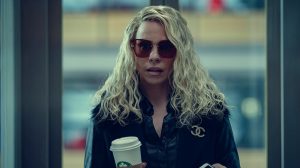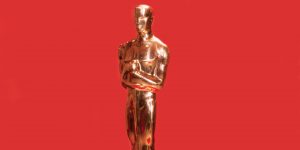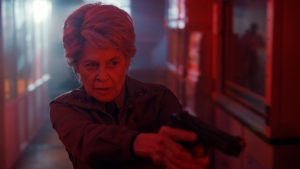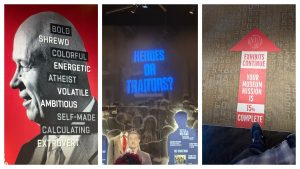
This post contains spoilers for Joker: Folie à Deux.
There are two general reactions from audiences coming out of Joker: Folie à Deux: “That was terrible,” and “Lady Gaga was good.” The idiosyncratic pop star continues to acquit herself well in movies, even with material as inert and dire as Folie à Deux. Yet despite coming out of the debacle with her head held high, Gaga’s take on Harleen Quinzel will likely go down in history as both different… and largely forgettable. Which to be fair is not unlike the many Elseworlds tales published by DC Comics.
In the same way the definitive comic book Harley remains the one drawn by Amanda Conner, and the definitive cartoon version is a neck and neck between Arleen Sorkin’s original in Batman: The Animated Series and Kaley Cuoco’s sweet and self-aware protagonist, Margot Robbie is still the only Harley Quinn in the movies who matters.
A Smile in a Joyless World
As different as Joker and Joker: Folie à Deux are, they share the same cynical worldview. With rare exceptions like Gary Puddles, everyone in that world exists to torment Arthur Fleck. Director Todd Phillips and his co-writer Scott Silver cannot imagine the traditional Harley in such a context, because in the standard telling, Dr. Harleen Quinzel is the one tormented by the man in clown makeup. That begins when she is introduced as the Joker’s psychologist at Arkham. Instead of treating the Clown Prince of Crime, she’s drawn into his world, losing all sense of identity. She is manipulated into becoming a fellow evil clown.
In Folie à Deux, Gaga’s Lee Quinzel is an East Coast rich kid who checks herself into Arkham in hopes of meeting Joker. As Arthur shies away from his Joker persona, Lee encourages it, pushing him to become the agent of chaos she saw kill Murray Franklin on live television. In theory, Phillips and Silver have a compelling inverse on the traditional Harley/Joker dynamic. The original dynamic plays far too loose with partner abuse tropes, something that’s not outside the realm of possibility for someone as evil as the Joker, but a strange fit for someone as popular as Harley Quinn. In Folie à Deux, it’s Lee who twists Joker.
Whatever value that inversion might have gets diluted by the despairing sludge that is Joker: Folie à Deux. Phillips and Silver leave no space to explore the relationship between the two, either within the film or within the context of both characters’ larger history. It’s just one more bad thing happening to Arthur, no different than him becoming a target for enterprising assistant DA Harvey Dent, an object of abuse for the guards at Arkham, or the legacy of his troubled mother.
No matter how compelling her performance, Lady Gaga can do nothing to elevate the character if the director isn’t interested in doing anything beyond bumming the audience out.
Her Own Woman
In fairness, Margot Robbie’s Harley Quinn didn’t begin in such a great place either. The legend of 2016’s Suicide Squad has been told time and time again. It’s a mess of a film that started as a bland David Ayer project and then was edited by a trailer production house to compete with the sillier tone of Guardians of the Galaxy. Still, Suicide Squad superficially embraces Harley’s status as a battered and abused girlfriend, whose one mission seems to be reuniting with the Joker (and the Jared Leto Joker at that). Although in one of the movie’s most galling sequences, villain Enchantress gives the Suicide Squad visions of their deepest desires. For Harley, it’s literally a “normal” suburban life with the Joker, complete with a pair of kids and her cooking dinner while her man is at work.
Like Phillips, Ayer has a fairly one-note take on Harley. She’s a crazy hot chick in short-shorts who deep down wants to be a submissive wife (anyone crying foul and calling for “the Ayer cut” in response to this charge clearly hasn’t seen the uniformly terrible and sexist movies that Ayer makes when he does have final cut). Yet Robbie brought an energy, pathos, and electricity to the character that transcended the character’s limitations in the script.
Fortunately, Robbie got to expound on her version of Harley two more times, first in the deliriously excessive Birds of Prey, Or the Fantabulous Emancipation of One Harley Quinn and then in James Gunn‘s The Suicide Squad.
Written by Christina Hodson and directed by Cathy Yan, Birds of Prey deals head-on with Harley’s problematic origin and relationship with Joker. She begins the movie breaking free of her abusive boyfriend and trying to find herself, something not so easy in a misogynistic world that hates women whether or not they dated murder clowns.
Although amped up to ridiculous degrees, Birds of Prey retains pathos in Harley’s plight. Anyone who has left an abusive relationship knows how hard it is to recover one’s sense of self, and the constant temptation to back to the “safe” relationship you once had, even if that relationship wasn’t safe at all. Sure, Yan and Hodson portray that desire through Harley’s battle with the face-peeling murderer Roman Sionis, aka the Black Mask (Ewan McGregor forced to awkwardly stand in for Joker due to the Leto of it all), and her community consists of female superheroes and supervillains, all hated by insecure men. But that core truth shines through the levels of glitzy, comic book excess.
Harley is, meanwhile, just a supporting character in The Suicide Squad, but Gunn wisely steps aside to let Robbie drive her own character’s arc. As with Birds of Prey, Harley’s story in this 2021 film remains fundamentally relatable underneath the over-the-top superhero excess. She’s tempted to fall back into a relationship with a bad man but finds the strength to stand up for herself and eventually finding beauty in the life she chooses. That standing up for herself might involve shooting the would-be dictator of a small country, and that beauty may climax with shoving a spear into the eye of a giant alien starfish, but the pathos is there.
The One and Only Harley Quinn
To the surprise of no one, Gaga’s best moments in Joker: Folie à Deux involve the fantasy sequences in which she and Joaquin Phoenix sing together, often on the set of a ’70s variety show. Of course, Gaga has a great voice and presence, and she fits snugly among these rare colorful sequences in the film. But even then, Gaga’s subordinated to Phoenix’s Joker, who manifests through flat, often shouted, versions of his songs. Worse, the color scheme, while a welcome break from the gray of the rest of the film, recycles the look of the first Joker film, itself lifted wholesale from Martin Scorsese’s The King of Comedy.
Contrast that to the fantasy sequence in The Suicide Squad, in which Harley visualizes herself as a Disney princess while absolutely slaughtering the guards trying to hold her. At once sweet and stomach-churning, vibrant and violent, the sequence doesn’t squash Harley to a single Joker-focused plot beat, but lets her shine in all of her contradictions.
Lady Gaga certainly has the potential to be a complex and compelling Harley Quinn, but Robbie has been a complex and compelling Harley Quinn, even in a terrible film, and we’d like to see her do it again in Gunn and Peter Safran’s new DC Universe.
The post Margot Robbie Is Still the Only Movie Harley Quinn appeared first on Den of Geek.





